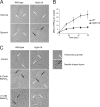Yeast aquaglyceroporins use the transmembrane core to restrict glycerol transport
- PMID: 22593571
- PMCID: PMC3390631
- DOI: 10.1074/jbc.M112.353482
Yeast aquaglyceroporins use the transmembrane core to restrict glycerol transport
Abstract
Aquaglyceroporins are transmembrane proteins belonging to the family of aquaporins, which facilitate the passage of specific uncharged solutes across membranes of cells. The yeast aquaglyceroporin Fps1 is important for osmoadaptation by regulating intracellular glycerol levels during changes in external osmolarity. Upon high osmolarity conditions, yeast accumulates glycerol by increased production of the osmolyte and by restricting glycerol efflux through Fps1. The extended cytosolic termini of Fps1 contain short domains that are important for regulating glycerol flux through the channel. Here we show that the transmembrane core of the protein plays an equally important role. The evidence is based on results from an intragenic suppressor mutation screen and domain swapping between the regulated variant of Fps1 from Saccharomyces cerevisiae and the hyperactive Fps1 ortholog from Ashbya gossypii. This suggests a novel mechanism for regulation of glycerol flux in yeast, where the termini alone are not sufficient to restrict Fps1 transport. We propose that glycerol flux through the channel is regulated by interplay between the transmembrane helices and the termini. This mechanism enables yeast cells to fine-tune intracellular glycerol levels at a wide range of extracellular osmolarities.
Figures





Similar articles
-
Identification of residues controlling transport through the yeast aquaglyceroporin Fps1 using a genetic screen.Eur J Biochem. 2004 Feb;271(4):771-9. doi: 10.1111/j.1432-1033.2004.03980.x. Eur J Biochem. 2004. PMID: 14764093
-
Yeast Fps1 glycerol facilitator functions as a homotetramer.Yeast. 2011 Dec;28(12):815-9. doi: 10.1002/yea.1908. Epub 2011 Oct 26. Yeast. 2011. PMID: 22030956 Free PMC article.
-
Deletion of FPS1, encoding aquaglyceroporin Fps1p, improves xylose fermentation by engineered Saccharomyces cerevisiae.Appl Environ Microbiol. 2013 May;79(10):3193-201. doi: 10.1128/AEM.00490-13. Epub 2013 Mar 8. Appl Environ Microbiol. 2013. PMID: 23475614 Free PMC article.
-
Structure, function and translational relevance of aquaporin dual water and ion channels.Mol Aspects Med. 2012 Oct-Dec;33(5-6):553-61. doi: 10.1016/j.mam.2012.02.001. Epub 2012 Feb 11. Mol Aspects Med. 2012. PMID: 22342689 Free PMC article. Review.
-
Yeast reveals unexpected roles and regulatory features of aquaporins and aquaglyceroporins.Biochim Biophys Acta. 2014 May;1840(5):1482-91. doi: 10.1016/j.bbagen.2013.09.027. Epub 2013 Sep 26. Biochim Biophys Acta. 2014. PMID: 24076236 Review.
Cited by
-
Metabolite secretion in microorganisms: the theory of metabolic overflow put to the test.Metabolomics. 2018 Mar 2;14(4):43. doi: 10.1007/s11306-018-1339-7. Metabolomics. 2018. PMID: 30830324 Review.
-
Are Aquaporins the Missing Transmembrane Osmosensors?J Membr Biol. 2015 Aug;248(4):753-65. doi: 10.1007/s00232-015-9790-0. Epub 2015 Mar 20. J Membr Biol. 2015. PMID: 25791748 Review.
-
Expression Analysis of Sugarcane Aquaporin Genes under Water Deficit.J Nucleic Acids. 2013;2013:763945. doi: 10.1155/2013/763945. Epub 2013 Dec 29. J Nucleic Acids. 2013. PMID: 24490055 Free PMC article.
-
Expression of the aquaglyceroporin HC-9 in a freeze-tolerant amphibian that accumulates glycerol seasonally.Physiol Rep. 2017 Aug;5(15):e13331. doi: 10.14814/phy2.13331. Physiol Rep. 2017. PMID: 28784850 Free PMC article.
-
Central Metabolic Responses to Ozone and Herbivory Affect Photosynthesis and Stomatal Closure.Plant Physiol. 2016 Nov;172(3):2057-2078. doi: 10.1104/pp.16.01318. Epub 2016 Oct 6. Plant Physiol. 2016. PMID: 27758847 Free PMC article.
References
-
- Tamás M. J., Luyten K., Sutherland F. C., Hernandez A., Albertyn J., Valadi H., Li H., Prior B. A., Kilian S. G., Ramos J., Gustafsson L., Thevelein J. M., Hohmann S. (1999) Fps1p controls the accumulation and release of the compatible solute glycerol in yeast osmoregulation. Mol. Microbiol. 31, 1087–1104 - PubMed
-
- Förster C., Marienfeld S., Wilhelm R., Krämer R. (1998) Organelle purification and selective permeabilization of the plasma membrane: two different approaches to study vacuoles of the filamentous fungus Ashbya gossypii. FEMS Microbiol Lett. 167, 209–214 - PubMed
Publication types
MeSH terms
Substances
LinkOut - more resources
Full Text Sources
Molecular Biology Databases

